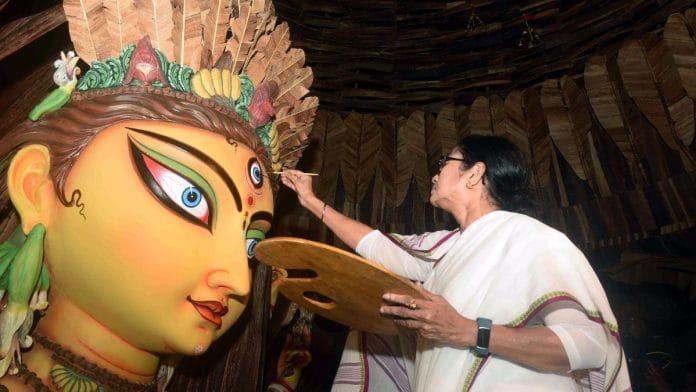Should a democratically elected government in a multicultural, multi-religious country sponsor a religious festival even in the most oblique of ways? Should it dole out cash to already well-funded organisers of the festival? Should taxpayers’ money in a cash-strapped State be extravagantly spent on a non-essential as if there was no tomorrow? These questions have been asked and repeatedly raised ever since West Bengal Chief Minister Mamata Banerjee started giving out the Durga Puja dole to organisers of the annual festivities in 2018.
The only answer has been even bigger doles.
But this year’s generous increment has drawn new attention to the now seven-year practice: Banerjee has increased her annual largesse by Rs 15,000 over the past year and has promised a matching amount in 2025.
Nothing in West Bengal has grown at the rate at which its Durga Puja budget has. In 2018, when the CM announced a Durga Puja gift for the first time, it was a sum of Rs 10,000 to some 28,000 clubs that hosted the goddess. Every year since, the number of clubs and the annual grant have grown in leaps and bounds. It shot up to Rs 25,000 in 2019, Rs 40,000 in 2020, Rs 50,000 in 2021, Rs 60,000 in 2022, and Rs 70,000 in 2023. And, instead of the usual Rs 10,000 leap, Mamata hiked the grant by Rs 15,000 to Rs 85,000 in 2024.
Next year, that amount is going to be one full lakh to 43,000 clubs, which will burn a Rs 430 crore hole in the state’s exchequer. Add to this the cost of partial or complete waiver of charges for electricity, fire brigade, and other civic services, and the additional hole in the state’s pocket could be of another Rs 200 crore. Or a total of at least Rs 600 crore.
Also read: West Bengal is locked in a loop of one horror story after another
Eyeing 2026
Banerjee is generous when it comes to Durga Puja and her efforts have borne fruit: In 2021, the festival got UNESCO’s coveted tag of Intangible Cultural Heritage of Humanity.
Certainly, a feather in her cap.
But the size of this year’s largesse and the next has set tongues wagging that it may be accompanied by a price tag: the absolute loyalty of the Durga Puja clubs in the 2026 assembly elections in the state.
Most of these Durga Puja clubs sit in urban clusters — 3,500 of them in Kolkata alone, the rest in suburbs in the districts. Now, in the just-concluded Lok Sabha election, the Trinamool Congress’ (TMC) performance in these urban clusters, including Kolkata, has left a lot to be desired, with the Bharatiya Janata Party (BJP) making some surprise inroads. The loyalty of the Durga Puja clubs in these areas could be politically vital to Banerjee. Nothing would be more powerful than the local Durga Puja club pushing a political agenda. Her’s.
Also read: Mamata’s bulldozers may backfire. Kolkata’s problem is poor infrastructure, not hawkers
Other legacies begging for attention
As for Kolkata’s heritage that the CM says she is trying to protect, it would be great if she could direct some of her generosity to other legacies begging for attention. The historic Writers Buildings, the seat of government in Kolkata that she abandoned for Nabanna in 2013, is apparently under repairs but with nothing to show in 11 years. A bunch of do-gooders are doing their bit to save the city’s historic ghats. Historic buildings are rotting, with trees taking over, like the magnificent palace of Raja Subodh Mallik in the heart of Kolkata. Not a peep from the government.
And, finally, the city’s trams. Kolkata is, perhaps, the only city in the world that has the tram, metro, and hand-pulled rickshaw. Now, the last is a legacy that should be done away with as soon as possible, and truth be told, the rickshaw has almost disappeared. But so has the tram. Surely the environment-friendly, relatively cheap mode of transport, deserves a better deal. But the government has little time of day for them and even less money.
An amount of Rs 600 crore invested into Kolkata’s trams annually could change the city’s environmental health. Temperatures in the city have risen faster than in any other metro in the country, according to some studies. A new line of the metro rail is going to see hundreds of trees reportedly removed and transplanted – an exercise that has a poor success rate – from the sprawling Maidan that is considered the lungs of the city. And the city is set to choke, perhaps even more than Delhi in the coming years.
But the government appears to have little time for anything that is not politically expedient. Durga Puja has become politically useful, and Banerjee is determined to make the most of it.
Monideepa Banerjie is a senior journalist based in Kolkata. She tweets @Monideepa62. Views are personal.
(Edited by Humra Laeeq)






